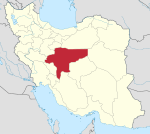Nain, Iran
Nain (Persian: نایین or نائين, also Romanized as Nā’īn & Nāeyn)[2] is a city and capital of Nain County, Isfahan Province, Iran. At the 2011 census, its population was 25,379 in 7,730 families.[3]
Nain نایین or نائین | |
|---|---|
City | |
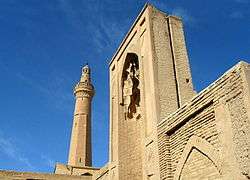 Mosque of Nain: Na'in has one of Iran's oldest mosques still standing | |
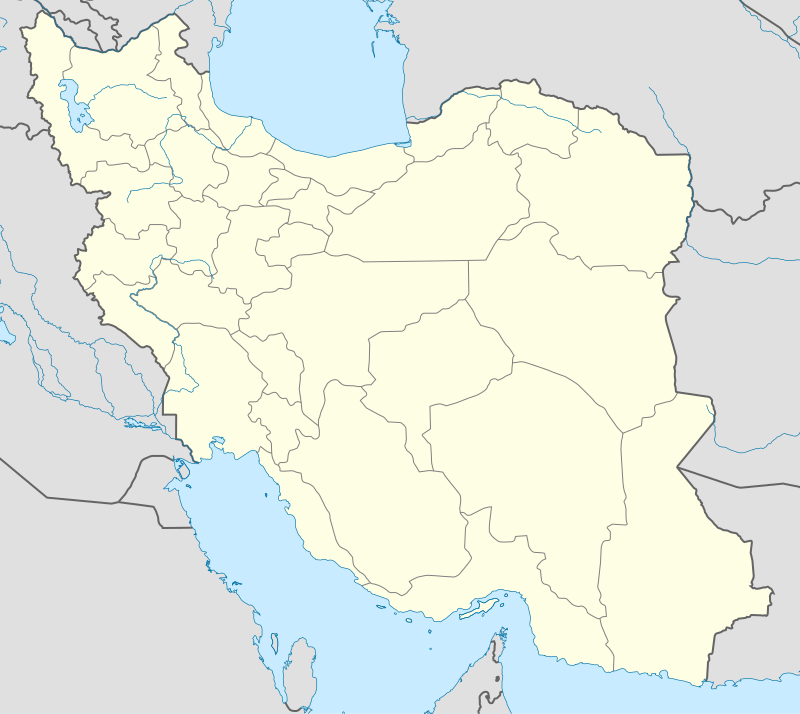 Nain | |
| Coordinates: 32°51′36″N 53°05′15″E | |
| Country | |
| Province | Isfahan |
| County | Nain |
| Bakhsh | Central |
| Population (2016 Census) | |
| • Total | 27,379 [1] |
| Time zone | UTC+3:30 (IRST) |
| • Summer (DST) | UTC+4:30 (IRDT) |
Na’in (also known as Naein and Naeen) lies 170 km north of Yazd and 140 km east of Esfahan with an area of almost 35,000 km², Na’in lies at an altitude of 1545 m above sea level. Like much of the Iranian plateau, it has a desert climate, with a maximum temperature of 41 °C in summer, and a minimum of -9 °C in winter.
More than 3,000 years ago the Persians learned how to construct aqueducts underground (qanat in Persianکاریز, or kariz) to bring water from the mountains to the plains. In the 1960s this ancient system provided more than 70 percent of the water used in Iran and Na’in is one of the best places in all the world to see these qanats functioning.
Unique to Na’in are some of the most outstanding monuments in all of Iran: the Jame Mosque, one of the first four mosques built in Iran after the Arab invasion; the Pre-Islamic Narej Fortress; a Pirnia traditional house; the Old Bazaar; Rigareh, a qanat-based watermill; and a Zurkhaneh (a place for traditional sport).
Besides its monuments, Na’in is also known for its carpets, wool textile and home made pastry ( copachoo) .
Some linguists believe the word Na’in may have been derived from the name of one of the descendants of the prophet Noah, who was called "Naen" . Many local people speak an ancient Pahlavi Sasani dialect, the same dialect that is spoken by the Zoroastrians in Yazd today. Other linguists state that the word Na’in is derived from the word "Nei" (“straw” in English) which is a marshy plant.
It has one of the earliest remaining mosques in Iran, and has a Sassanid era fort, now in ruins, called Narin Ghal'eh.
It extensively uses ab anbars. Nain is most famous in the world for its rugs.
Jame Mosque
The initial construction of Jame Mosque dates back to the 8th Century CE, but the whole of the complex has been constructed incrementally.
One of the oldest mosques in Iran, its magnificent plasterwork over the niche, the marvellous brickwork around the yard, and its silent basement—which may have been used as a fire temple before the mosque was built here—are only a few of the features of this mosque.
This mosque has no Iwan and dome as do the other famous mosques in Esfahan and Yazd. A 28 m tall octagonal minaret was added to the mosque almost 700 years ago.
If you stand in the middle of the yard, you will find yourself surrounded by fourteen columns, each one adorned with a unique and intricate pattern of brickwork.
You might also be interested in the alabaster stonework which reflects sunlight throughout the basement.
One of the most exquisite pieces of artwork inside the mosque is the wooden marquetry pulpit (Persian: menbar). The carpenter matched the wooden parts together like a pieces of a puzzle. The pulpit is decorated with organic geometrical designs. According to the wooden inscription on the left side of the pulpit, it was created about 700 years ago.
An underground water channel runs underneath the mosque. There is a stairway that connects the mosque to the water channel and to chambers above the pool. In the past, people used the water for ablutions before prayers.
The basement used to be a prayer chamber in hot summers and cold winters. The temperature in the basement is always moderate, never varying more than 10 to 15 degrees. The basement wasn’t actually built; it was dug into the ground, which means no materials were used to construct it.
The entrance fee is 100,000 rial. The mosque is open Tu-Su 08:00-21:00 in summer or 08:00-17:30 in winter.
Rigareh water mill
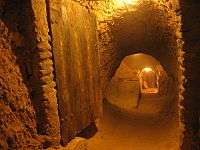
The ancient Rigareh—a qanat-based water mill—is located in the Mohammadieh neighbourhood.
The age of this engineering masterpiece is unknown; however, some historians believe that it dates back to the pre-Islamic era.
The water is supplied by the Keykhosrow qanat channel and the mill is placed almost 28 m underground. The access corridor to the mill is about 133 m long.
A qanat channel crosses 9 meter above the mill and fills the huge 9 meter diameter water tank. When enough pressure is provided, the water is released and rotates the turbine.
The waste water flows out along the channel and joins the main qanat channel with a gradual slope 15 meter further down.
This is one of few places in the country where visitors can get inside a living flowing Qanat accessible through a 12 m corridor.
Since the advent of electricity to grind the wheat and barley, this water mill has become a part of history.
Pirnia traditional house and ethnology museum
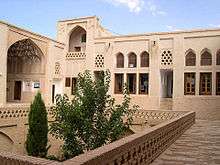
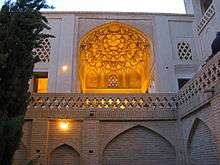
The Pirnia traditional house is a perfect example of this region's desert houses in terms of architecture and art and was constructed in the Safavid Period.
The house consists of an exterior, an interior, a deep garden, a silo room and all of the facilities that a lord’s house needed to have at the time it was constructed.
When you enter the house and pass the first corridor, you reach an octagonal room called “hashti”, which used to be a waiting room for clients and visitors.
Paintings, plasterwork of Qur'anic stories, a book of poems and calligraphy decorate the living room.
First, a judge of Na'in lived there. Then, during the Qajar Period, the house belonged to a governor of Na'in. Just a few decades ago, the house was purchased by the Ministry of Culture and Art. - After renovation in 1994, the house was converted into the desert ethnology museum.
The entrance fee is 100,000 rial and the museum is open Tu-Su 08:00-21:00 in summer and 08:00-17:30 in winter.
Mosallah edifice
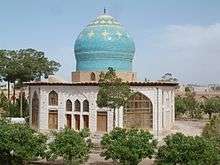
The Mosallah is another monument in Na'in. Its vast garden used to be a recreational area until a few years ago. The mausoleum inside the Mosallah was a pilgrimage site for visitors. The dome of the Mosallah is opposite the dome of the shrine of Emamzadeh Sultan Seyyed Ali and these two are connected by a street. There is a water reservoir on one side of the garden, which can be accessed by people inside and outside the garden through a stairway on each side. Water in this reservoir was cooled by two wind towers. The water reservoir (Persian: ab-anbar) was in use until a few years ago. The architectural style of Na'in's Mosallah is characteristic of the Qajar dynasty and a number of literary, political and religious figures are buried at this site. “Mosallah” is an Arabic word for a place of prayer but, no one knows if any praying was ever done at this location. The Mosallah is an octagonal mausoleum of dervishes and Qajar and Pahlavi political figures. It is encompassed by a Qajar-era military fort with a high wall thick enough for a horse to be ridden along the top. The pistachio trees around the turquoise-domed mausoleum and two tall wind towers make the complex very photogenic. The entrance fee is 50,000 rial and the site is open to the public 08:00-12:00 and again 15:00-17:00.
Castle of Narenj
Narenj Qal'e is a remnant of a structure that was also known as Narin castle. The construction materials used in the castle, as well as its style of architecture support the idea that it was built in the pre-Islamic era. According to surveys and other evidence, this monument might belongs to the Partiyan period.
The exact use of the castle is not known. However, it is thought to have been part of the military and official compounds of the city. Many researchers of the Safavid era have spoken of numerous castles known as Narikh Qalae, which were used for military purposes. Hence, it can be concluded that Naeen's Narikh Qalae was also a military establishment. The historian and researcher, Estakhri mentioned there was a moat with a 3,000 ft perimeter dug around the castle.
Bazaar
The Bazaar is another of Na'in's historical attractions.
The bazaar extends 340 m in a curved line from the Gate of Chehel Dokhtaran to the mosque of Khajeh Khezr and is connected by main alleys as well as by tributary passages to centres of neighbourhoods. The bazaar has two crossroads or chahar su.
Parts of the bazaar have been renovated and the many and varied shops in the bazaar were active until a few years ago.
However, nowadays the bazaar has been almost deserted since the retailers moved to the city's streets.
A number of Na'in's important monuments, such as the mosque of Sheikh Maghrebi, the mosque of Khajeh, and the Hosseinieh of Chehel Dokhtaran are still noteworthy facets of Naein’s extraordinary bazaar.
Zurkhaneh
Zurkhaneh, Zorkhana or Zourkhaneh (in Persian/Kurdish: زورخانه, literally "house of strength") is house of strength, joy of effort, generosity and chivalries spirit, love of country and combined with art and literature. Zurkhaneh is a sport of values.
This sport with the thousands years of history has played a great role in empowering the mental and physical health aspects of the people. Zurkhaneh Sports is a cultural heritage and good resource for Sports for All.
Indeed, many countries are boosted from a social as well as humanitarian perspective. By proclaiming IZSF events, many countries have acknowledged just tidy influential role of Zurkhaneh sports that can play in a country’s social, well-being and cultural development. there are 3 zurkhaneh in Na'in but the Valiye Asr Zurkhaneh located in Valiye ASr street is the most suitable to visit.
Aba bafi man made caves
In Muhammadieh, a precinct of Na'in, there are some man-made caves. Locals call them sardab and aba bafi.
Evidences show that they were dug by the Zoroastrian inhabitants who used to live there because the cave entrances open to the east where the sun rises.
After they were abandoned by the Zoroastrians, Muslim inhabitants used them as loom workshops to weave cloaks and rugs.
There is an ancient fort over the hill, 150 m away, with a small entrance at the back.
There is no fee for visiting the caves or the fort. The caves are open dawn to dusk, with a short break from noon to 13:30.
Weaving cloaks by hand is one of the most valuable handicrafts and historical arts of Na'in. Some of the workshops are 700 years old.
Naein’s winter textiles are very famous and are woven from two types of sheep and camel wools. Clothing styles have changed, but the cloaks are still quite famous in some Arab countries.
Fatemi House
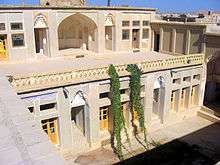
Fatemi House is the grandest traditional house in Na'in. It is located in front of Narenj Castle, beside the old bazaar of Na'in.
The house was originally the possession of one of the most influential families in Na'in.
Fatemi House consists of a large number of sections, each one with a different function: winter living rooms, summer living rooms, stable, resting rooms, silos, corridors, dining rooms for guests, and other facilities.
Most of the rooms are furnished with stained glass windows, inlaid wooden doors, and plasterwork. The house is now the property of a cultural heritage organization.
Mohammadieh
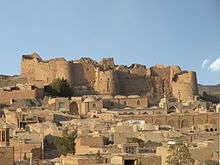
The village of Mohammadieh is located about 2 km east of Naein and also houses the Jameh and Sar Kuche Mosques, a fortress, the ancient Rigareh watermill and the cloak workshops.
The mosque of Mohammadieh was built in the late 10th and early 11th Centuries CE. The altar of the mosque and the ceilings on the two sides of the mosque's nocturnal prayer hall or Shabestan resemble the Jameh Mosque of Na'in.
Handy knot carpets
Handmade products in Na'in are very important. Weaving carpets, a fine art, began in Na'in about the time of World War II.
Because carpet weavers from Na'in worked with thinner wools, they began to weave rugs of much higher quality.
Since the number of carpets produced was low and the quality of carpets was exceptionally high, the weavers found a profitable market.
Carpet-weaving in Na'in has a history of using non-Iranian wools and of using local, traditional designs with unique colouring, thus drawing the attention of the world market to Na'in.
Na'in’s carpets are woven in diverse places in Iran, thanks to the advent of technology. Weavers throughout Iran can weave any kind of carpet. But a prospective carpet buyer should consider that the quality of the same kind of carpet, in different places, is different.
Na'in style carpet is woven in different places in Iran - but the quality will be very different in each place.
One reason that carpet actually woven in Na'in is so popular, is that it uses predominantly natural and traditional colours rather than synthetic dyes.
Other reasons include the sheer quality of the weft obtained from using mainly wooden looms.
Desert trekking and mountaineering
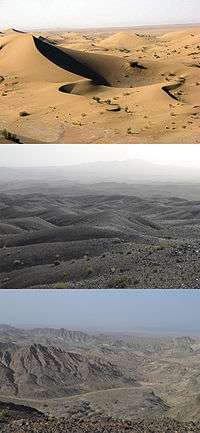
Desert trekking is one of the possibilities for sightseers in this desert town, since a desert with moving sand dunes surrounds Na'in. It's desert trekking on real moving sand dunes.
There are sand hills from 5 to 62 meters that always moving when the wind blows. The highest sand dunes in Iran.
Also sleeping (camping) on the moving sands and having breakfast there if you like.
The same man who rents bicycles can also organize the budget tours to the desert. google naeinsun on internet.
There are some desert-type mountain surrounded west and north east of Na'in. The one on north east (as you see in the middle and lower photo) is worth of visit.
there are some unpaved roads lead there. down hill bicycle is recommended. but do not visit there alone. also there is a walking tour called survival tour in the mountainous area in range of 5 km, 10 km and 15 km available. For more info call the local guide.
There is a local guide who has bicycles to rent and also accompany you to the mountaineering.
Sleep
There are numerous locations of accommodation around the city.[4]
The historical complex of Babol Masjid, where the Jameh Mosque is located, is a free, quiet, secure place for camping for those who like to stay outdoors. It is popular among cyclists, bikers and backpackers. The camping area is the open part of Hussainieh.
The public rest room is always open. The locals are very friendly and helpful. The Hussainieh is off-limits only during religious ceremonies.
Transport
There is a regular bus To Esfahan almost every half an hours is available in the only bus station of the town. also private Taxi would be available 24 hours a day on the "Falake Esfahan", Esfahan roundabout. departing the town to Yazd is possible by waiting for the buses to Yazd in "Falake Esfahan", Esfahan roundabout or taking a taxi to the Yazd Road police station.
Three buses per day travel to Tehran (US$4, six hours) via Kashan (US$2.50, 2½ hours). Two of these travel between Na’in and Jonub and one between Na’in and Beihaghi Arjantin).
Notable people
- Reza Ghanbari Naeini, Founder of Al Zahra Hospital for Women with Mental Retardation in Naein, well known carpet trader and humanitarian. 1951-2007.
- Hassan Pirnia or Moshiroddoleh (Persian: حسن پيرنيا ملقب به مشيرالدوله), Prime minister of Iran in Qajar Dynasty and author, 1871-1935.
- Dr. Hossein Fatemi, (Persian: دكتر حسين فاطمي), Minister of foreign affairs in Mossadeq's cabinet, 1919-1954.
- Ali Kaffashian, president of the Iranian Football Federation
- Muhammad Hossein Naini, (Persian: محمدحسین نائینی), One of the first Iraninan clergies questioning dictatorship in Iran, Author of the book Tanbih-ol-ommah va tanzih-ol-mellah, 1861-1936.
- Dr. Seyed Gholamreza Jalali Naeini, President of the Iranian Ergonomics Society, Chairman of the Iranian Management Association and former UN official and ILO Chief Technical Advisor for SADC.
- Rashid Massumi, M.D., Physician and Professor, Pioneer in the fields of Electrophysiology and Cardiology
References
- https://www.amar.org.ir/english
- Nain, Iran can be found at GEOnet Names Server, at this link, by opening the Advanced Search box, entering "-3076275" in the "Unique Feature Id" form, and clicking on "Search Database".
- "Census of the Islamic Republic of Iran, 1385 (2006)". Islamic Republic of Iran. Archived from the original (Excel) on 2011-11-11.
- https://en.wikivoyage.org/wiki/Na%27in#Sleep
External links
| Wikivoyage has a travel guide for Na'in. |
| Wikimedia Commons has media related to Nain, Iran. |
- Isfahan East News Agency
- NaeinNews.ir
- Pictures of Naein and its vicinity townships
- Photographs of Nā'in:
